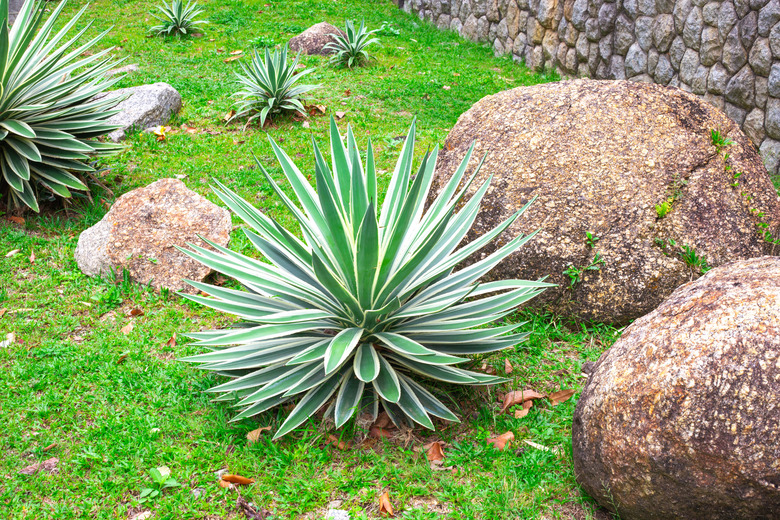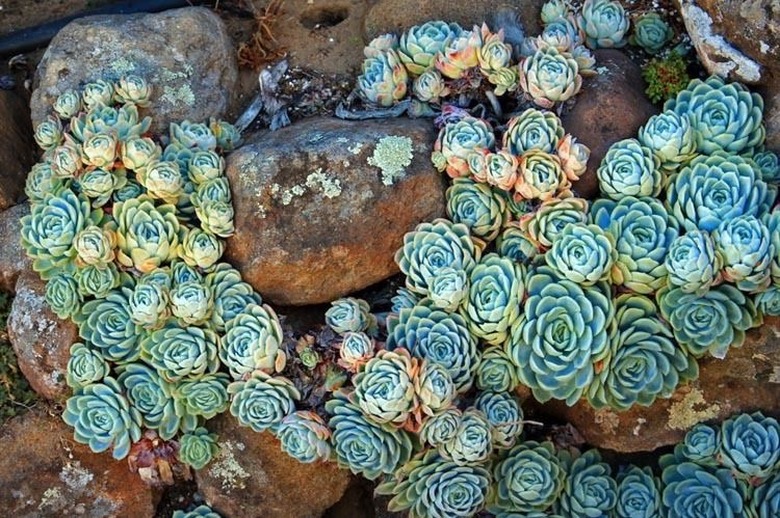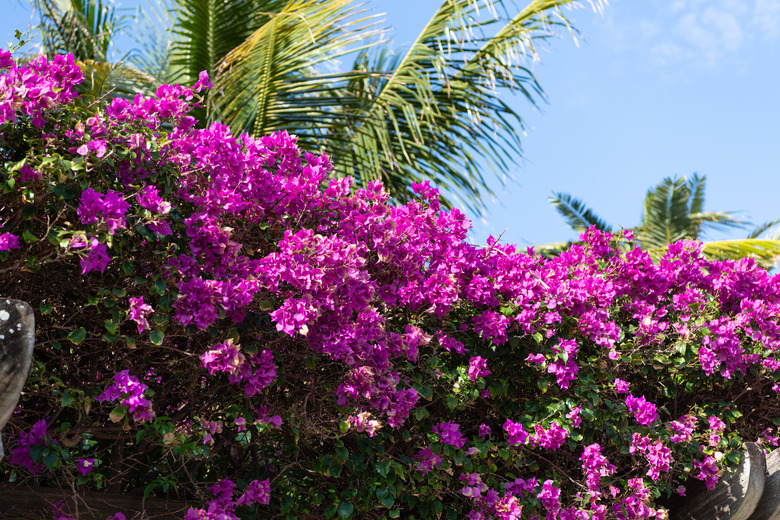13 Desert Plants To Use When Landscaping
We may receive a commission on purchases made from links.
At first glance, the desert may seem like an endless swath of lifeless land. But in fact, the desert is home to hundreds of plant species — including a variety of wildflowers, cacti, trees, shrubs, and grasses. Desert plants come in a variety of colors, shapes, and sizes that allow them to easily transform landscapes into living works of art. Whether you fancy turning your backyard into a desert-chic oasis, or you're just looking for landscaping options that are a little more drought friendly, now is the perfect time to brush up on your knowledge of desert greenery. Here are 13 of the most common desert plants to help you curate the yard of your dreams.
1. Curve Leaf Yucca
1. Curve Leaf Yucca
Curve leaf yucca, Yucca gloriosa var. tristis, is one of the most ubiquitous desert plants, with over 40 known varieties, and their visual appeal doesn't end with their lively bundle of bright green spears. As a member of the agave family, their leaves will curl under as the plants grow, and they'll also bloom fragrant flowers. When it comes to caring for a yucca plant little is required, but drainage is essential.
2. Golden Barrel Cactus
2. Golden Barrel Cactus
The uniquely short, round shape of the golden barrel cactus (Echinocactus grusonii) makes it a visually striking addition to any landscape design. Of the many types of cacti, this particular one works well as part of a rock garden (or any geometrically inclined landscape design, really) thanks to its spherical form — but don't get too attached. Over the years, the globes might change shape, transforming into cylinders as the plants grow. These cacti can appear in multiple shades of green with needles in different shades of yellow, as the occasional bright yellow flowers bloom from their tops.
3. Ghost Plant Succulent
3. Ghost Plant Succulent
Chances are that you've seen these low-maintenance succulents popping up more frequently in well-landscaped exteriors as of late. The rose-like shape of the ghost plant, Graptopetalum paraguayense — not to be confused with Monotropa uniflora, which also goes by the name 'ghost plant' — appears in a large range of sizes. While they're predominantly dusty green in hue, there are times when the rosettes have an appropriately rosy tint around the edges. Ghost plants are great for rock gardens, along pathways, as garden borders, or arranged in planters.
4. Paddle Plant or Red Pancake
4. Paddle Plant or Red Pancake
Most frequently referred to as 'paddle plant,' this succulent goes by a number of whimsical names, including 'red pancake,' 'flapjack,' and 'desert cabbage.' It's scientific name is Kalanchoe thyrsiflora. The 'red' in 'red pancake' refers to the color around the edges of each leaf, which spreads and intensifies under full sun exposure. These low-water desert plants are also low-maintenance, requiring minimal care in order to thrive. Thanks to their color-changing capabilities, paddle plants have the potential to add dramatic splashes of red to any desert landscape design.
5. Foxtail Agave
5. Foxtail Agave
When shopping for desert plants, you'll find that many species of agave exist, but fox tail agave (Agave attenuata) is the one that's growing in popularity the most. This is no doubt thanks to the way that the plant's pleasantly curved leaves burst from the ground like fireworks. When fully grown, the leaves will curl downward while a large stalk (blanketed in tiny blooms) grows from the plant's center, and tight clusters of rosette flowers fill in the base. Arguably the best feature of foxtail agave is that, unlike many other species, it's perennial — which means that it's enduring, and pretty much looks good year round.
6. Mexican Feather Grass
6. Mexican Feather Grass
The delicate blades of Mexican feather grass, or Stipa tenuissima, are ideal for creating a magical beach-like atmosphere. This desert plant is one of the secret weapons of landscape design. Considered an ornamental grass, Mexican feather grass is wispy, fine-textured, and has a beautiful lime green color. Because it's so stunning, you may be tempted to plant loads of the stuff. But use caution, as the plant will readily grow and spread. The plant has a much more complex root structure than regular lawn grass, which means that it's not so easy to get rid of.
7. Jade Plant or Friendship Tree
7. Jade Plant or Friendship Tree
Jade plants (Crassula ovata) fall somewhere between a tree, flower, and shrub. Sometimes referred to as 'friendship trees,' they're usually the size and shape of a small bush. During the fall and winter months, the waxy green leaves of jade plants are temporarily eclipsed by an abundance of (slightly pink) white flowers in bloom. As a drought-resistant plant, jade doesn't require much water, but it does love sunshine.
8. Flaming Katy
8. Flaming Katy
Affectionately known as a 'flaming katy,' Kalanchoe blossfeldiana, a cousin of the paddle plant, exists in numerous colors and provides bright, puffy, long-lasting flowers when in bloom. This is a great desert plant for adding pops of color to your desert landscape. When not in bloom, flaming katys have flat, curved green leaves similar to (but larger than) a paddle plant's. When they do bloom, their densely packed flowers open with a giant splash of color.
9. Aloe Vera
9. Aloe Vera
With its myriad of medicinal uses, aloe vera is a fantastically versatile addition to any landscape design. Though often mistaken for a cactus, aloe vera actually belongs to an entirely different family of succulent — it just happens to grow into cactus-like shapes from time to time. The required care can vary based on the size and type of your aloe plant. Since their leaves are already filled with all of that aloe-y goodness, aloe vera plants need to be watered sparingly.
10. Texas Sage
10. Texas Sage
The lavender-colored blooms on Texas sage (Leucophyllum frutescens) may be small, but they're sturdy. For the majority of the year, Texas sage seems to be an unassuming green shrub, but come summertime, and tiny flowers in shades of lavender, periwinkle, and blue cover its branches, where they'll remain through the fall. Like other desert sage, Texas sage won't need to be pruned, and the plant fares best in full-sun exposure.
11. Yellow Bells
11. Yellow Bells
These bright, sunny flowers grow quickly and bloom abundantly. Appropriately named for their shape and color, yellow bells (Tecoma stans) are wildflowers with vibrant yellow, bell-shaped blooms. Care considerations for yellow bells (such as watering and pruning) will vary by climate, but all require full-sun exposure.
12. Bottlebrush
12. Bottlebrush
Callistemon plants yield unique flowers whose blooms bear a striking resemblance to bottle brushes. The unusual bloom of a bottlebrush plant (which is also referred to as a bottlebrush tree, although it grows in shrub form as well) immediately catches the eye — and attracts hummingbirds — with the brightly colored needles that form the flower. The variety of bottlebrush that's most often used for landscaping has flowers that are bright red in color; however, other species of bottlebrush do exist in different hues.
13. Bougainvillea
13. Bougainvillea
A frequent sight throughout the Mediterranean, this fast-growing plant comes in a range of colors, the most popular of which are magentas. Bougainvillea (Nyctaginaceae) grows in beautifully wild configurations — sometimes as bushes, vines, or even ground cover. With patience and training, it's also possible to create a bougainvillea tree.













